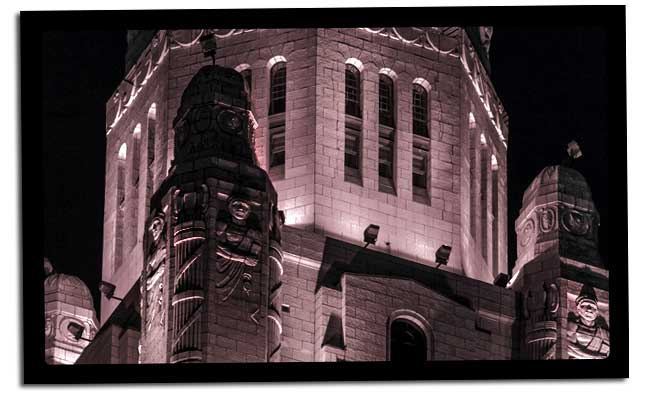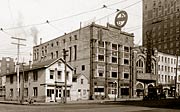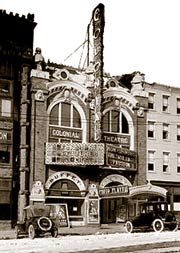
LeVeque Tower
The LeVeque Tower at 50 West Broad Street has long been the defining image of Columbus' skyline.Originally constructed by the American Insurance Union, the building became known as the AIU Citadel or sometimes just the Citadel.
The American Insurance Union was the creation of local businessman and politician John J. Lentz. Since its incorporation in 1894 the company had enjoyed phenomenal growth as an interesting mixture of insurance company, secret society and social club.
Rising 555.5 feet into the sky, the Citadel was intentionally built 6" taller than the Washington Monument. However, with modern day measuring tools, it has been determined that the Washington Monument is actually taller than originally thought, but, the Tower is still taller, but only by about 3/8".

The LeVeque Tower as it is now called, was the tallest building in Columbus from 1927 to 1973 when the Rhodes State Office Tower on East Broad Street across the street from the Statehouse was completed. For years the tower acted as a lighthouse for passing aircraft and for motorists coming across the National Road, the flashing red light could be seen for miles away.
During construction of the tower, 5 construction workers lost their lives. The caisson foundation extends 112' below street level and 10,000 tons of steel-reinforced concrete form the building's structural system. Originally the building had a large brick smokestack coming out of the top. The exterior walls are faced with white oak bark terra-cotta.
The groundbreaking ceremony was held September 23, 1924. Dedication ceremonies were held September 21, 1927.

The building is festooned with eagles, arcane symbols and figures of people from ancient mythology and the ritual of the organization. The terra-cotta eagles guarding the main entrances have wing spans of 25'. Originally there was a statuary group 495' above the street on all sides of the tower, a 26' tall man embracing two children. The exterior ornamentation was executed by Chicagoan Fritz Albert after designs by New York sculptor Carl H. Keck. A bronze plaque with the horoscope of the tower and the positions of the planets at the time of the laying of the cornerstone (February 12, 1925) is set in the lobby floor.

Today, if you look closely just below the micro-wave dishes near the top, you can see the giant stone eagles with outstretched wings. Behind these wings is a narrow walkway that goes around the outside of the top.
 Scioto River Cleanup
Scioto River Cleanup
The Leveque Tower was just part of a larger project to cleanup and develop the Scioto River area. Prior to this the Scioto River flooded frequently, in fact, the 1913 flood destroyed the Broad Street Bridge and much of Franklinton which lies on the west side of the river. Along with the new tower, the city also built City Hall, widened the river, and built a concrete retaining wall on both sides. Prior to this, the river was lined with slums that went right down almost to the water's edge.

The Great Depression
When the Great Depression came, it caught the AIU short of funds. Money that should have been used to keep the company liquid, were needed to pay for the structure when building costs ran over, due to unforeseen difficulties. Within a few years the American Insurance Union failed and the future of the building was uncertain. By 1935 the American Insurance Union having been forced into bankruptcy, sold the building to a group led by Leslie LeVeque of Columbus and John Lincoln of Cleveland (founder of Lincoln Electric). At that time the building became known as the Lincoln-LeVeque Tower.
 The building was added to the National Register of Historic Places in 1975. In 1977, the name was officially changed to the LeVeque Tower. The building later changed hands to Lennar Properties in 2004, and then again to the new owners Finsilver/Friedman Management, a Michigan based regional developer and property manager.
The building was added to the National Register of Historic Places in 1975. In 1977, the name was officially changed to the LeVeque Tower. The building later changed hands to Lennar Properties in 2004, and then again to the new owners Finsilver/Friedman Management, a Michigan based regional developer and property manager.
Exterior Lighting
At different times of the year, the exterior lights on the tower will be changed to reflect different occasions. Red and green for Christmas, pink for Breast Cancer Awareness Month, all green for St. Patrick's day and of course red, white and blue for July 4th. The rest of the time it is illuminated with just white light. The colors have to be changed manually by placing gels over the lamps.
For many years the tower was not lit, but thanks to the efforts of Doug Adair, a local Channel 4 anchorman, he successfully (after a few tries) managed to get the building lit through the cooperation and support of many people and it has been lit just about every night since.





